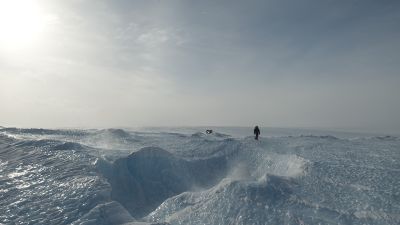
We Are StarDust (part 2)
The Antarctic Plateau is unlike anything that you have ever seen, and even the most talented writers or photographers have systematically failed to capture its many-faceted no-holds barred un-sentimentality. The frames of reference are totally lacking to transmit such a complex phenomenon carved up by the raw, primeval forces of nature. Everything here is alien. Magma and ice. The imagination would be hard put to create a facsimile that would do it justice.
The Prinoths return, we shackle up and are soon on the plateau proper. The route follows Alain’s route across Antarctica for a while, and we encounter the first giant sastrugi, almost a metre high, and with the scaly reticulated surface and the sharp gaping jaws that were such a torture to him back when he had the bright idea to do this crossing. My jaw would drop if I weren’t so transfixed. The idea of getting out and walking here is not immediately appealing. Yet there is a breed of person who would, and they elbow and clamour for the privilege of doing so.
Today the tables are turned on the sastrugis and with grim satisfaction Alain locks down on them with the giant claws of the Prinoth: crab versus shark. Erik and I come to the same conclusion. It is pure revenge. The icy sharks fall before the blades with an eerie sound of shattering glass. There is too a certain glassy quality to Alain’s stare. He is focussed. We have driven in rotation for more than seven hours without eating or drinking, in an effort to get to the JARE 31 camp by the evening. The Japanese were the last to come this way more than 20 years ago. We can now understand why no-one else has dared venture this far since, and why everyone who has is so tense and nervous about it. It’s not even that it is so far in geographical distance. The going is slow because the terrain is so uneven with another kind of sastrugis. These are shaped like turtles and crocodiles rearing up out of the ice with their hardened carapaces in defiance of our mechanical power, threatening to overturn the sledges. The crevasses on the edge of the ice fields are more visible and therefore “easier” to handle. The convoy snakes around finding a safe path through the minefield of potential swallowing depths.
By the time we get to camp, we have been driving for 12 hours, and are hungry, thirsty and tired from the mental strain of the journey. We set up our tents while the snow melts. Rene is so tired and bedraggled after so long in the chilling wind as he took his shift on the skidoo as outrider, that he falls into his tent and sleeps until morning. We eat “fast food” (a quick omelette) and fall into a torpor in our sleeping bags. I haven’t had time yet to think of altitude.
In the morning, we are woken by the flapping of the tents. The wind has picked up, and visibility has fallen, as The Plateau bares it’s fangs in a warning snarl. My eyelashes freeze together as I make a gasping dash to the ten-foot container where we have our kitchen. Have to find my goggles. Kristof builds a gigantic snow wall with the Prinoths to protect the vehicles and the accommodation units of the scientists who will be staying here when we leave. Even so protected, the fragility of our condition is evident. The Inmarsat satellite footprint just misses us, so no e-mail or satphone apart from the Iridium. Then the generator begins to cough and choke most appallingly – the altitude has its first victim. By the second day, we no longer want to attempt to restart it every ten minutes. The snow as well manages to enter the smallest crevice or gap and by morning all machinery is choked up and air inlets have to be freed up before we can start it again. New Year’s Eve in this place. It has to be done.
Around five in the afternoon, the weather opens a little and in a show of defiance, Alain and I don our skidoo suits, get on to the trusty “Black Beauty” and head off for a spot of reconnaissance on the blue ice west of the JARE 31 camp. The feeling of being on another planet is palpable. We criss-cross the rising blue bulk of the ice field where the gentle ripples of ice give way to razor sharp little ridges, pitted like some giant reticulated leaf.
Suddenly, a black lump of burnt rock. Our first meteorite of the season. And as it turns out our last. By the time we turn to go back to the camp two brief hours later, it is no longer visible. Alain is disdainful of this attempt to unnerve us on the part of The Plateau. He makes a dismissive noise, and by GPS we are soon back in camp brandishing our precious booty. (Editor’s note for the younger generation: As in pirate booty). Steven is beaming from ear to ear and beyond if possible. It’s true. There be meteorites here. This one is called poetically A-20101231-01. We are under strict injunction not to touch it with our bare hands lest we contaminate it.
Attempting to celebrate the find proves less simple than we imagine, as it takes about two minutes for champers to freeze solid in the glass. Happy New Year.
Picture: The blue ice on the Antarctic Plateau - © International Polar Foundation - René Robert
